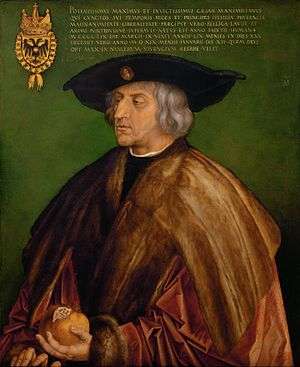Portrait of Emperor Maximilian I
The Portrait of Emperor Maximilian I is an oil painting by Albrecht Dürer, dating to 1519 and now at the Kunsthistorisches Museum of Vienna, Austria. It portrays the emperor Maximilian I.
| Portrait of Emperor Maximilian I | |
|---|---|
 | |
| Artist | Albrecht Dürer |
| Year | 1519 |
| Type | Oil on linden wood |
| Dimensions | 74 cm × 62 cm (29 in × 24 in) |
| Location | Kunsthistorisches Museum, Vienna |
History
In the Spring of 1512, the newly elected emperor Maximilian I of Habsburg sojourned in Nuremberg, where he got acquainted with Dürer. To celebrate the emperor and his house, the artist conceived the large Triumphal Arch woodcut, for which he was rewarded with 100 yearly florins.

In 1518, during the Diet of Augsburg, Maximilian called Dürer to portray him. The artist met the emperor in the castle and made a pencil drawing of him, from which he later painted the panel portrait. On the drawing's margin, he noted: "Is the emperor Maximilian that I Albrecht Dürer portrayed in Augsburg, up in the high palace, in his small room, Monday 28 June 1518".
The oil panel was completed when the emperor had already died, with some variants from the initial drawing. The latter is now housed in the Albertina, Vienna.
Description
The emperor is portrayed from three-quarter on a green background. The arms lie on an unseen parapet coinciding with the lower boundary of the painting, according to the Flemish painting tradition. His left hand holds a large pomegranate, a symbol of cohesion in diversity and thus of the Holy Roman Empire (the grains representing his subjects).
Maximilian wears a gown with a very wide fur collar and a broad-brimmed dark hat, with a brooch in the center. His grey hair crown his aged (Maximilian was 59 at the time) but still aristocratic face.
In the upper left is the Habsburg coat of arms and Golden Fleece chain, near a long inscription in capital characters which gives the titles and the deeds of the emperor.
POTENTISSIMVS. MAXIMVS. ET. INVICTISSIMVS. CAESAR. MAXIMILIANVS/ QVI. CVNCTOS. SVI. TEMPORIS. REGES. ET. PRINCIPES. IVSTICIA. PRVDENCIA/ MAGNANIMITATE. LIBERALITATE PRAECIPVE. VERO. BELLICA. LAVDE. ET/ ANIMI. FORTITVDINE. SVPERAVIT. NATVS. EST. ANNO. SALVTIS. HVMANAE./ M.CCCC. LIX. DIE. MARCII. IX. VIXIT. ANNOS. LIX. MENSES. IX. DIES. XXV/ DECESSIT. VERO. ANNO. M.D.XIX. MENSIS. IANVARII. DIE. XII. QVEM. DEVS/ OPT. MAX. IN. NVMERVM. VIVENCIVM. REFERRE. VELIT
Sources
- Costantino Porcu, ed. (2004). Dürer. Milan: Rizzoli.
.jpg)